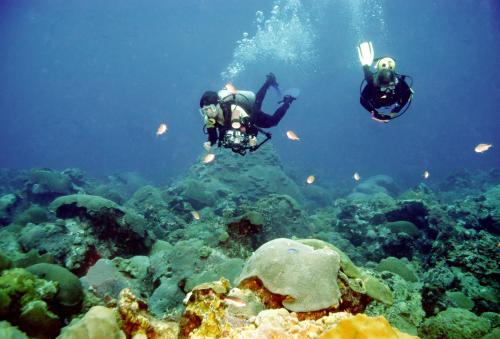Derived from invited article submitted by Gregory S. Boland, former BOEM employee.
This year, the Department of the Interior (DOI) celebrates nearly 50 years of environmental protection of the Flower Garden Banks (FGB), an extraordinary coral reef habitat that serves as a sentinel site in the Gulf of Mexico. The FGB are the northernmost coral reefs on the continental shelf of North America. They are located approximately 115 miles southeast of Galveston, Texas, and are considered one of the healthiest coral habitats in the western hemisphere.
Protective measures are needed to preserve the exceptional coral composition and extremely diverse fish and invertebrate populations. To this end, the DOI has been conducting investigations through its Environmental Studies Program, formed in 1973, to explore and document biologically sensitive topographic features in the Gulf of Mexico, including in the FGB.
Early Studies
In 1975, oil and gas exploration was beginning to move into the deeper waters in the Gulf of Mexico. At this time, no wells had been drilled near the FGB, and exploration studies were focused on describing the topographic features and sensitive biological habitats that could be impacted by the impending oil and gas development activities.
During these earliest studies, a great deal of effort was invested on determining the effectiveness of protective measures, including measures to avoid potential impacts of drilling near these banks. From these studies, two major protective measures were developed: No Activity Zones (where no activity of any kind is allowed) and shunting zones (where drilling materials are directed into deeper water).
A potential impact of concern was that sediment deposited onto reefs can smother corals and interfere with their ability to feed, grow, and reproduce. Using current meter studies, dye experiments, and physical modeling, study results indicated that shunting drilling materials directly into the deeper water surrounding the FGB would avoid sedimentation of these sensitive coral habitats. These studies were a primary driver for shunting zone requirements, which are still in place today.
DOI also designated a No Activity Zone around the FGBs and nearby banks to create a protective boundary that encompasses the sensitive and diverse benthic habitats of the banks and the associated organisms. The No Activity Zone boundaries were largely determined by depth contour and related biological habitat development as observed by submersible. In addition to the shunting zone requirements, these measures have proven effective since their creation nearly 50 years ago.
Long-Term Monitoring
Long-term monitoring of the FGB began in 1988. Permanent photographic stations and a variety of other monitoring techniques conduct consistent and ongoing monitoring of the corals.
In 1992, the National Oceanic and Atmospheric Administration (NOAA) designated the FGB a National Marine Sanctuary, meaning it was deemed a special place worthy of Federal protection. Shortly after designation, NOAA became a full partner in the funding and performance of the monitoring efforts. Now, the FGB National Marine Sanctuary conducts the monitoring cruises using their own research vessel, with input and partnership funding from DOI’s Bureau of Ocean Energy Management.
The Payoff
Annual monitoring provides critical timing of first alerts for changes in live coral condition. The thriving coral reefs of the FGB are considered a sentinel for detection of habitat change, and, if changes are observed, increased focus would be directed to determine the causes if there are links to offshore energy activities.
For example, in August 2022, the devastating coral disease called “stony coral tissue loss disease” was discovered at the FGB. This disease already had caused extensive devastation of corals throughout Florida and the Caribbean. The FGB National Marine Sanctuary has made efforts to understand and treat this disease outbreak; the existing long-term monitoring data and repeated photographic stations play a highly significant role in determining the impact of and recovery from this event.
Protection of the FGB from oil and gas activity impacts through environmental stewardship has been seen as a success. The FGB have continued to exhibit extraordinary environmental health, and protective measures have prevented impacts from over decades of energy development in the vicinity.
|
Repetitive camera frame used to obtain same bottom monitoring image over time. Here used on the West Flower Garden Bank during first long-term monitoring study in 1989 funded by MMS to Texas A&M University. Steve Gittings taking photo who becomes first manager of the Flower Garden banks National Marine Sanctuary in 1992. (Photo by Gregory S Boland) |
Dye experiments to determine regulations for oil and gas activity discharges to protect Flower Garden Banks. An array of packets of green fluorescein dye (from shark repellant packets on old Navy life vests) were lowered to the sea bed to observe water transport dynamics. Taken September 1977 as part of an early contract from BOEM predecessor- Bureau of Land Management to Texas A&M University. (Photo by Gregory S Boland) |
-- BOEM --
The Department of the Interior’s Bureau of Ocean Energy Management (BOEM) is responsible for America’s offshore energy and mineral resources. The bureau promotes energy independence, environmental protection and economic development through responsible, science-based management of energy and mineral resources on the U.S. Outer Continental Shelf.





